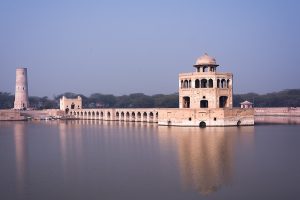
I’ve been writing about Mughal garden performance, and have become fascinated with the contradictory character of the emperor Jahangir, whose journals are filled with wonder, curiosity and violence.
This tower (left of image), erected in what was once Jahangirpur, marks the grave of a tame antelope, Hansraj, used as a decoy to hunt wild animals by the emperor in the 17th century.
In 1613, Nuruddin Muhammad Salim, Jahangir, ‘world-seizer’, writes as though his hunting has tamed the empire:
During the felicitous reign of this petitioner at the divine court wildness has been eliminated from the nature of wild beasts to such an extent that lions have become tame and roam in packs among people, without restraints or chains, and they neither harm them nor run away. (May 1613:144)
Alongside demonstration of royal puissance and territorial claim, there was, during the period, also a spiritual-erotic idea of ‘the yearning of the prey for the hunter,’ which codes and exculpates the emperor as divine (see Koch 1998: 27). Akbar’s biographer, Abu’l Fazl, mentions practices of luring deer, in which they are almost seduced towards their own destruction.
These methods can be performative – the deer are led with lights, bells or musical instruments, and even hunters charming the deer with a song, but Abu’l Fazl also says that Akbar condemns such practices, and Jahangir (his son) also seems to avoid them (though he’s always one to find a way around self-imposed prohibitions) (Abu’l Fazl and Blochmann, 2010 [1598]: 292).
In fact, many of the techniques mentioned by Abu’l Fazl contrive a deceptive performance in order to capture deer:
The keepers will also bend forward and allow the trained deer to jump on them from behind. Wild deer, on seeing this, will think that they are in the act of copulation and will come near to fight. This way of hunting is disapproved of by His Majesty… (Abu’l Fazl and Blochmann, 2010 [1598]: 291).
Another method of confusing a deer is for the hunter ‘to throw himself into odd attitudes. The deer then mistakes him for a mad man, and from curiosity will approach him’. Sometimes the hunter ‘acts as if he were wounded. Wild animals and others will soon gather round him, waiting for his death; but their greediness and desire lead them to destruction.’ (Abu’l Fazl and Blochmann, 2010 [1598]: 292-3).
Yet another is when the hunter, camouflaged with green twigs, hiding behind a tree, will ‘imitate the voice of deer. As soon as deer approach him, he kills them’ (Abu’l Fazl and Blochmann, 2010 [1598]: 292).
In all these examples, the deer are required to become a naïve audience, whose outrage, curiosity, aesthetic pleasure, conviviality, or self-interest are all manipulated by the human actor. (There is something very familiar about this, I think!)
If these tragic scenarios are enacted by Jahangir, or his servants, he does not mention them. Rather, Hansraj, the tame antelope, would have been sent out with a net or weighted cord (phana) on his antlers – when the wild antelope engaged him in a fight, it would become entangled and could be captured or killed. Predictably enough, Hansraj himself was accidentally shot in 1607. With characteristically belated remorse, Jahangir then honoured him with a monument, and a gravestone ‘in the shape of an antelope’. The dedication carved on the tower, remembering Jahangir’s relationship to the antelope, says approvingly ‘Within a month it had lost its wildness’ (March 1607:69).
The idea of an eliminated wild, or wilderness, renders living beings as tame and the landscape as a garden. This monument, Haran Minar (Deer Tower), is one of many examples of Jahangir’s taming of the landscape and has elements of literal garden design – pavilion, tank, border and surrounding park and gardens.
The conflicting nature of the emperor’s responses thread through his memoirs. While Jahangir lays claim to nature, he is also in a close and constant exchange with it. Every sense is invoked in his writing, and emotion, too. He notes down anything that strikes him as strange or notable: of an enormous markhor goat he comments excitedly that he had ‘never imagined such a thing. I ordered the artists to draw its likeness’ (July 4th 1607: 78-9).
He describes flowers – the champa, dog roses and jasmine, saffron crocuses and roses, often commenting specifically on the scent: ‘when in blossom, one tree will perfume a whole garden’ (1605: 24). Cherries are his particular passion: ‘Cherries have an amazing appearance on the tree – like butterflies. You’d think they were chunks of round ruby suspended from the branch’ (June 1607: 76). He comments that ‘picking fruit with one’s own hand gives an entirely different pleasure’ (January 1618: 245).
Jahangir moved from ‘garden to garden’, as he put it himself, shifting from one encampment to the next (March 1617:214). He visited the Deer Tower again in 1621, and then in 1624-5, noting with satisfaction the baradari, tank and fort that had been constructed: ‘Now it is really an imperial hunting ground’ (November 1620: 350).
A week after his second visit to Jahangirpur, he is camped in the garden of Mu’min Ishqbaz: a pretty garden, he says, full of cypresses and plane trees. From there, he processes into Lahore, on the back of an elephant, scattering coins, accompanied by the music of the royal procession.
Abu’l Fazl, Blochmann, Heinrich (trans.), 2010 [1598] The Ain I Akbari of Abul Fazl ‘Allami: Text and Translation, Piscataway, NJ, USA: Gorgias Press, 2010.
Koch, Ebba, 1998. Dara-Shikoh Shooting Nilgais: Hunt and Landscape in Mughal Painting. Washington D C: Smithsonian Institution.
Nuruddin Muhammad Salim, Emperor Jahangir, Thackston, Wheeler M, (trans. and ed.) 1999. The Jahangirnama: Memoirs of Jahangir, Emperor of India. Washington D C: Smithsonian Institute.
